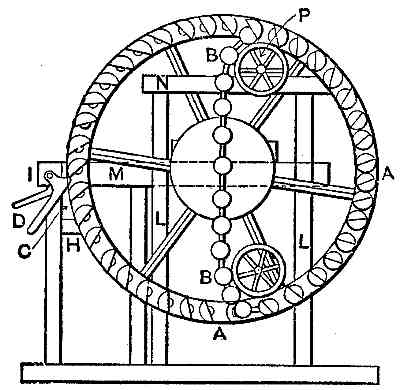French,
1858
The invention
consists in communicating a rotary motion to a fly wheel or drum by
means of a set of falling weights tied together by chains, ropes, or
straps. This set of weights, forming an endless chain, runs over two
pulleys, suitably disposed A up and down near the fly wheel, which is
provided with a set of cups fixed around its periphery, so as to
receive the weights as they are delivered by the upper pulley, and to
carry them down to the lower pulley, whence the same weights reascend
in a straight direction to the upper pulley.

The weights of
the endless chain running or falling down in the
curvilinear direction of the periphery of the drum are more numerous
than those that are raised up in a straight line, because the
curvilinear line is longer than the straight one, and the difference of
heaviness due to the number of weights is the force which, by its
action at the end of the levers or radii of the drum, causes that drum
to rotate.
(Subsection 926, from
p.370)
From: Gardner D. Hiscox, M.E., Mechanical Appliances and Novelties of Construction (1927), Norman W. Henley Publ. Co.






